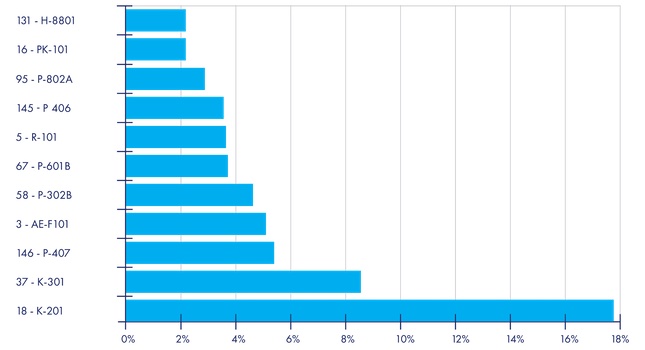Don’t ignore the challenges or the solutions when integrating optimum power systems.

In the pursuit of integrating optimum power systems, facility engineers and IT managers are tasked with selecting the optimum power quality equipment. However, in the rush to protect vital computing, automation, PLCs, and other process control assets, often critical power management systems are overlooked, or disparate and poorly integrated power monitoring and management software is implemented that is unable to address the most common and pressing power-related challenges.
Though no two organizations are exactly alike, IT and facilities staffs often face similar power monitoring and management issues. The following actions will take a facility’s power management to a much higher level of operational continuity.
The logic of redundancy applies as much to power protection schemes as it does to uninterruptible power systems (UPSs) designs (Figures 1 and 2). Building multiple power paths into a power design inherently increases reliability.
Figure 1 illustrates two simple but important points: Power path components that are serially connected, like Subsystems A, C, and D, weaken overall reliability. Power path components that are parallel redundant, like Subsystem B, improve overall availability. That is because a failure in Subsystems A, C, or D could take down the entire power path. Subsystem B, by contrast, has three parallel components. If one of them goes offline, the others compensate for it, keeping the system as a whole functioning.
Protect workloads during outages
UPSs offer crucial assistance by providing emergency backup power. However, should an electrical outage exceed the runtime of the UPS batteries, organizations must shut down affected servers promptly to prevent software corruption and data loss. Many managers must execute that process manually, forcing them to engage in a high-stakes race against time whenever they encounter a prolonged power loss.
Intelligent power management software helps technicians deal with power outages more efficiently. For starters, the latest power management solutions let technicians divide receptacles on their UPS hardware into separate load segments that can be monitored and administered individually. This conserves battery capacity and maximizes the amount of backup power available to keep mission-critical devices up and running.
Manage virtualized servers
Eager to lower hardware spending, simplify management, and ensure continual uptime, businesses are rapidly implementing server virtualization in their data centers. In fact, nearly 50% of server workloads will be running on virtual machines by the end of 2012, according to analyst firm Gartner Inc.
Many organizations use virtualization management software to administer their virtual environments. Such systems provide centralized control over host servers, virtual machines, storage, and more.
At present, though, many users of virtualization management suites must employ a separate set of management tools to monitor their power infrastructure, weakening the productivity of their technicians and potentially delaying response times when problems occur. Intelligent power management solutions integrate closely with leading virtualization management products, enabling IT and facilities personnel to view, monitor, and administer not only physical and virtual servers but UPS, PDUs, and other power devices through one console.
They also enable virtualization management products to provide a comprehensive view of network and power-related alerts that spare administrators from having to watch for alarms in two or more different places, dramatically reducing the chances of serious issues going unnoticed.
Moreover, drawing on seamless integration with live migration systems, intelligent power management solutions can automatically and transparently move virtual machines from host servers impacted by a power outage to unaffected servers elsewhere on the network; they can even move virtual machines to co-located cloud data centers. As a result, businesses can weather even serious power outages without suffering data loss or application downtime.
Administer remote facilities
Most large companies maintain multiple data centers, and even midsize organizations often have IT assets in more than one place. However, the power management systems that most businesses utilize at present can support only one site at a time. To access those systems, technicians often must use a dedicated workstation physically located within the facility being managed. Intelligent power management solutions, by contrast, can monitor and control network-enabled power devices wherever they are positioned.
Technicians can administer not only the facility they are in, but remote data centers as well through the same console. Through Web-based interfaces, IT and facilities managers can run systems from any device in any location, so long as it is equipped with a browser and has access to the network.
Track power quality assets
Data centers and plant facilities are dynamic environments in which equipment is constantly being added, removed, and relocated. As a result, IT and facilities managers often struggle to maintain complete and accurate records of how many power devices they own and where those devices reside.
Intelligent power management solutions simplify asset tracking by making it easy to record changes in an organization’s power infrastructure, such as moves, additions, and retirements. And since the latest power management systems have visibility into every power system on the network, their asset tracking abilities extend beyond the one facility to branch and local deployments as well.
Additionally, most intelligent power management software offers functionality that technicians can use to file notes about the physical location of power and environmental devices, further simplifying asset management. Finally, some power management systems interface automatically with asset management solutions, further streamlining the asset tracking process.
Adopt use-based billing schemes
Looking to apportion costs more fairly and encourage more efficient consumption of resources, facilities are increasingly adopting use-based electricity billing schemes in which facility managers charge a company’s various divisions separately for their share of the power bill.
Collecting the division-level usage statistics necessary to make such schemes work, however, can be a challenge.
Intelligent power management software helps simplify that task by enabling managers to monitor and manage power quality devices in groups that correspond to their various business units. They can then create reports showing how much power each group consumed, and bill the appropriate business unit accordingly.
For most organizations today, upgrading firmware on UPS connector cards is a tedious and expensive process in which technicians must physically visit and update each device individually. Intelligent power management software, however, enables administrators to upgrade all of their UPS hardware at once over the network; significantly reducing the cost and complexity of rolling out new commands, features, and functions.
Conclusion
By implementing the next generation of power management solutions, IT, engineering, and facilities personnel can view comprehensive information about network-enabled power and environmental systems, protect both physical and virtual servers during power outages, perform proactive maintenance, and more — from any location and on any device with a network connection and Web browser.
Organizations eager to preserve data integrity and keep mission critical systems continuously available should further investigate the latest power management products to learn more about the assistance they can offer in critical yet often overlooked power management.
Tessier is a product manager for Eaton single-phase UPSs, power monitoring software, and connectivity products. His 25-year career in technology organizations includes product management for personal computer options and monitors. Tessier can be reached at JamesTessier(at)Eaton.com.



